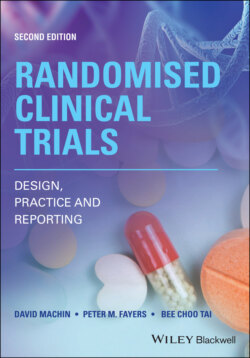Читать книгу Randomised Clinical Trials - David Machin - Страница 63
2.9.1.1 Intention‐to‐treat (ITT)
ОглавлениеDespite every effort to commence treatment as soon after randomisation as possible, there will be circumstances when the patient nevertheless refuses the treatment allocated or may even request the alternative option. In double‐blind trials, requesting the other option, at an early stage postrandomisation, would be very unlikely but in an open trial where the patient is fully aware (and can recognise the option), this will be more of a problem. However, even if a patient commences the intervention in question, they may subsequently refuse to continue with it and even wish to withdraw from the trial entirely.
The intention‐to‐treat (ITT) principle is that once randomised the patient is retained in the allocated group for analysis whatever occurs, even in situations where a patient is randomised to (say) A but then refuses and even insists on being treated by option B. As we have previously indicated, the effect of such a patient is to dilute the estimate of the true difference between A and B. However, if such a patient were analysed as if allocated to treatment B, then the trial becomes no longer truly and totally randomised since patient choice rather than chance has determined the allocation in such cases. The resulting comparison may then be seriously biased to an unknown extent and direction. In contrast, analysis based on the ITT principle ensures that for a trial established to demonstrate superiority of one intervention over another, any estimate of their difference is if anything biased towards the null. In this case, although some bias may be present, we know what the consequences will be. For example, in a trial in which there are patients who may have diluted the difference yet an ITT analysis still demonstrates a clear difference between the treatment options, then the investigators can reasonably infer that there is indeed a difference.
In contrast, the difficulty with analysing a trial by the treatment patients actually received is that we do not know the direction of the bias. Clearly if there are relatively few patients who do not receive their allocated intervention, then this is not likely to be a major issue. Conversely, if the numbers are large, then this would be a major concern and may render the trial results untrustworthy.
One procedure that was once in widespread use was for the investigating team to review the trial data in detail after the protocol treatment and follow‐up were complete and all the trial‐specific information collected so as to decide which patients should be in the final comparison. This review would, for example, retrospectively check that all the patient eligibility criteria were satisfied and that there had been no important protocol deviations whilst on treatment. Only if eligibility and compliance to protocol (however defined) were confirmed would the subject be deemed eligible for the analysis. Usually, this review would not be blind to the treatment received, and even if the trial were double‐blind, there may still be clues once the data are examined in detail as to which treatment is which.
One problem is that this process tends to selectively exclude patients with the more severe disease. Evidence for selective exclusion of patients following such reviews is provided by Machin, Stenning, Parmar, et al. (1997) who examined the published and pioneering portfolio of the early randomised trials conducted by the UK Medical Research Council in patients with cancer. They showed that the earlier publications systematically excluded patients from analysis and hence reported on fewer patients in the more aggressive treatment arm, despite a 1 : 1 randomisation. Thus, for example, any patient who had difficulties with this treatment, perhaps the sicker patients, were not included in the assessment of its efficacy and this systematic exclusion would tend to bias the results in its favour.
